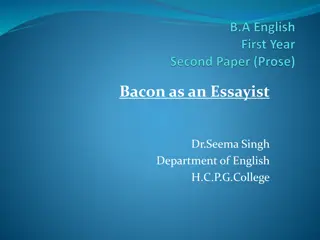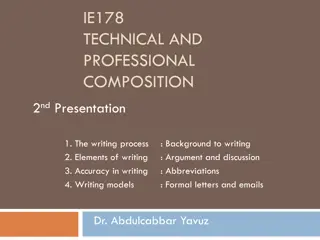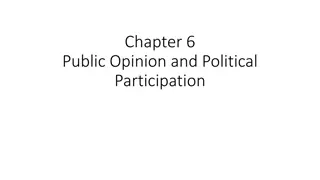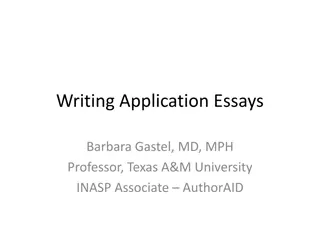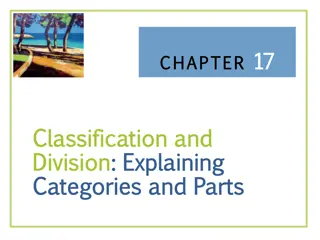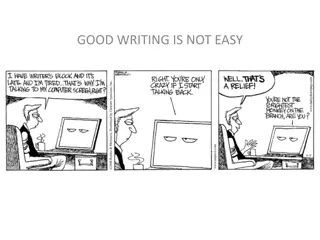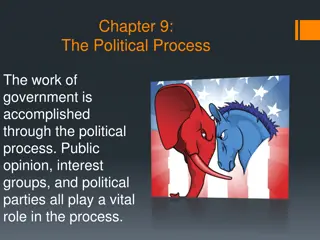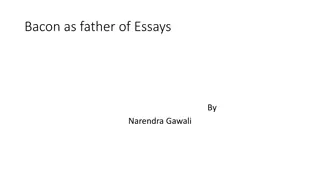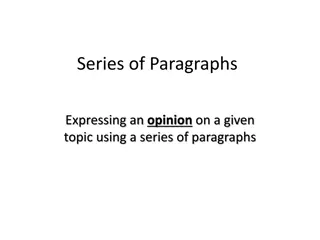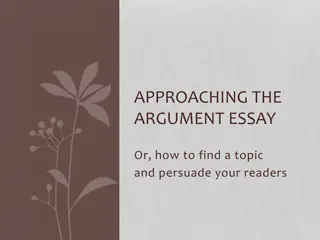Mastering the Art of Writing Opinion Essays
An opinion essay is a literary piece where the author expresses their stance on a topic with concrete arguments, supported by examples and reasoning. It typically consists of an introduction, three body paragraphs for arguments, and a conclusion. The introduction sets the stage, stating the topic and thesis. The body expands on main points with evidence, and the conclusion reinforces the author's position.
Download Presentation

Please find below an Image/Link to download the presentation.
The content on the website is provided AS IS for your information and personal use only. It may not be sold, licensed, or shared on other websites without obtaining consent from the author.If you encounter any issues during the download, it is possible that the publisher has removed the file from their server.
You are allowed to download the files provided on this website for personal or commercial use, subject to the condition that they are used lawfully. All files are the property of their respective owners.
The content on the website is provided AS IS for your information and personal use only. It may not be sold, licensed, or shared on other websites without obtaining consent from the author.
E N D
Presentation Transcript
What is an essay? An essay is a piece of literary work where the author presents their opinion on a given topic by providing concrete arguments which he further supports with examples and/or logical reasoning. The author may: 1. Completely agree with the topic; 2. Partially agree with the topic; 3. Completely disagree with the topic. The writer must stick to their position at all times and not change their opinion throughout the essay.
Structure of an essay An opinion essay usually consists of five paragraphs: Introduction; Body part which includes three paragraphs, one for each argument: First argument Second argument Third argument Conclusion
Introduction of an opinion essay The introduction s purpose is to act as a starting point of your essay. Here writers can start by restating the topic with their own words and provide some general background information or context. Next the writer should express their position on the topic and introduce their thesis statement. Finally, the writer must present their main points which they re going to use in order to support their opinion. Generally speaking your introduction should include the following three notes: General statement, Thesis statement and Exposition of main points
Example of an introduction Topic: What is the ideal pet? Pets have been a part of human life for millennia and for good reason: their companionship, friendliness and love for their owners couldn t be substituted for anything else. People who own a pet generally feel more relaxed, loved and are more focused. But what is the ideal pet? In my opinion, cats are a perfect choice for a pet: they re friendly and cuddly, they are clean animals and they do not require your constant attention. General statement Thesis statement Main points
The body part The body is the central part of an essay and arguably the most important one. Here the writer can support his position on the topic by further developing the main points he presented in the introduction. Notice that each main point is reviewed in a paragraph of its own. In the body part the writer should develop each of his main points individually in order to present a convincing argument for his thesis statement. The writer can further support his argumentative points by giving examples, either from history or from his personal life and by citing legitimate sources.
Example of a body part First of all, cats are very friendly and can easily adapt to people. If you have a cat as pet and you walk home from work you will always be greeted with a pleasant meowing and a high-sprung tail which indicates that the cat acknowledges you and that it likes you. Next, the animal will usually come to you and rub itself against your legs, which is to show that it is at ease in your company and that it missed you. Furthermore, cats love to cuddle! If you or your friend want to sit down and relax the cat will come and sit on your lap, in expectation for cuddles. They are also very playful so you should prepare some toys for it to play with. Secondly, cats have a very good personal hygiene. Never will you see a cat doing its business anywhere in the house! They are very easily taught to use a potty or a litterbox for their needs and they will never make a mess of it. Moreover, cats like to clean themselves with their tongues, a sort of a tongue bath . Whenever they feel dirty they will groom themselves to wash away the impurities and also to make their fur shiny. While it is true that cats may leave hair on the furniture, it can very easily be avoided if you regularly groom your cat with a hair brush.
Finally, cats are an excellent choice for a pet because they are self- sufficient and do not require special attention. Unlike dogs, which always need to play with their owner or otherwise require their full attention, cats are very laid-back creatures that can take care of themselves whenever their owner can t spare the time. A cat will stay quietly on the sofa, or play with a toy, or even look outside the window in order to avoid boredom. What s more, cats aren t bothered at all if they re left alone for some time. In fact, wild cats are known for being solitary creatures which prefer to hunt and raise their young alone.
Conclusion In the conclusion of the essay the writer summarizes their opinion on the topic and provides a general overview on the problem. Here the author may make a suggestion how to solve the problem stated in the topic or even make predictions about the future. But it is very important not to present new ideas in the conclusion or contradict his thesis statement! The conclusion has to strengthen your opinion and give the essay a finishing touch, not weaken your previously stated opinion.
Example of a conclusion To summarize cats will make an excellent pet in your home because they are friendly, playful, do not require special attention and they are self-sufficient. They are perfect for people who want to relax in a high chair while watching a movie or just want to unload the stress from the day with the help of a fuzzy little friend who will always be there for them.
Useful linking words for your essay Sequence: first/firstly, second/secondly, third/thirdly, next, last, finally, in addition, moreover, furthermore, another thing, also, in conclusion, to summarize, to sum up, in a nutshell Result: as a result, as a consequence, therefore, thus, consequently, hence, due to Emphasis: undoubtedly, indeed, obviously, generally, admittedly, in fact, particularly/in particular, clearly, especially Reason: for, because, since, as, because of Example: for example, for instance, that is (i.e.), such as, including, namely Contrast: however, nevertheless, nonetheless, still, although, even though, though, but, yet, despite/in spite of, in contrast to, in comparison, while, whereas, on the other hand, on the contrary Comparison: similarly, likewise, also, like, just as, just like, similar to, same as, compared to/with, not only but also





